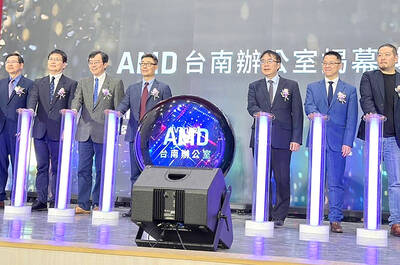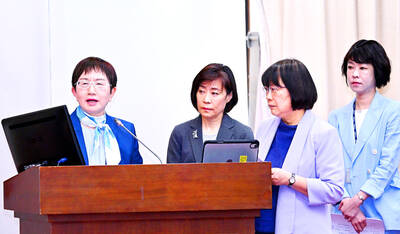The nation’s leading indicators rebounded for the sixth straight month last month, evidence that the economy is bottoming out, the Council for Economic Planning and Development (CEPD) said yesterday.
However, recent rising crude oil prices will be a major source of uncertainty for both the global and Taiwanese economy, it said.
The leading indicator index, which is used to gauge the economic outlook for the near future, increased 0.9 percent from a month earlier to 130.1 points, the council said in its monthly report.
The index’s annualized six-month rate of change, which provides a more accurate forecast of the business cycle in the near term, climbed 1.3 percentage points to 5.5 percent last month from a month ago, marking six months of consecutive improvements, the report said.
“The upturn of leading indicators, which offers the outlook for the upcoming four to six months, showed the economy might bottom out in the first quarter,” Hung Jui-bin (洪瑞彬), director-general of the council’s economic research department, told a press conference.
The pace of decline in some domestic business indicators in finance and consumption moderated last month amid the eurozone’s improving debt problem and moderate economic recovery in the US, Hung said.
However, some indicators in trade and production — such as growth of exports and imports — remained weak, he added.
Meanwhile, recent rising crude oil prices and slowing growth in China this year might pose downside risks for the global economy this year, Hung said, adding that the government would carefully watch these uncertainties.
Overall, Hung said he expected the annualized growth of Taiwan’s economy to improve quarter-by-quarter this year, in line with current market consensus.
The coincident index slid 0.7 percent to 125.9 points last month from a month earlier, with its trend-adjusted index dropping 1.3 percent to 93.6, the council said.
The overall monitoring indicators flashed “blue” for the fourth straight month last month, with the total score of the indicators rising two points to 15 last month, the report’s data showed.
In related news, the consumer confidence index (CCI) rose for the third straight month this month, mainly on back of improving confidence on the local stock market, a National Central University survey showed yesterday.
The index inched up 1.53 points to 81.26 this month, according to the survey.
The CCI benchmark gauges public expectations about the stock market, household finances, durable goods, job opportunities, consumer prices and the economic outlook for the next six months.
This month’s survey — which polled 2,422 people over the age of 20 from March 19 to last Wednesday last week — showed increasing uncertainty over consumer prices, but improved sentiment about other sectors, the university’s Research Center for Taiwan Economic Development said.

TECH CLUSTER: The US company’s new office is in the Shalun Smart Green Energy Science City, a new AI industry base and cybersecurity hub in southern Taiwan US chip designer Advanced Micro Devices Inc (AMD) yesterday launched an office in Tainan’s Gueiren District (歸仁), marking a significant milestone in the development of southern Taiwan’s artificial intelligence (AI) industry, the Tainan City Government said in a statement. AMD Taiwan general manager Vincent Chern (陳民皓) presided over the opening ceremony for the company’s new office at the Shalun Smart Green Energy Science City (沙崙智慧綠能科學城), a new AI industry base and cybersecurity hub in southern Taiwan. Facilities in the new office include an information processing center, and a research and development (R&D) center, the Tainan Economic Development Bureau said. The Ministry

ADVERSARIES: The new list includes 11 entities in China and one in Taiwan, which is a local branch of Chinese cloud computing firm Inspur Group The US added dozens of entities to a trade blacklist on Tuesday, the US Department of Commerce said, in part to disrupt Beijing’s artificial intelligence (AI) and advanced computing capabilities. The action affects 80 entities from countries including China, the United Arab Emirates and Iran, with the commerce department citing their “activities contrary to US national security and foreign policy.” Those added to the “entity list” are restricted from obtaining US items and technologies without government authorization. “We will not allow adversaries to exploit American technology to bolster their own militaries and threaten American lives,” US Secretary of Commerce Howard Lutnick said. The entities

Minister of Finance Chuang Tsui-yun (莊翠雲) yesterday told lawmakers that she “would not speculate,” but a “response plan” has been prepared in case Taiwan is targeted by US President Donald Trump’s reciprocal tariffs, which are to be announced on Wednesday next week. The Trump administration, including US Secretary of the Treasury Scott Bessent, has said that much of the proposed reciprocal tariffs would focus on the 15 countries that have the highest trade surpluses with the US. Bessent has referred to those countries as the “dirty 15,” but has not named them. Last year, Taiwan’s US$73.9 billion trade surplus with the US

The Taipei International Cycle Show (Taipei Cycle) yesterday opened at the Taipei Nangang Exhibition Center, with the event’s organizer expecting a steady recovery in the industry this year following a tough last year. This year, 980 companies from 35 countries are participating in the annual bicycle trade show, showcasing technological breakthroughs and market development trends of the bicycle industry at 3,600 booths, the Taiwan External Trade Development Council (TAITRA, 外貿協會) said in a statement. Under the theme “Ride the Revolution,” the exhibition has attracted more than 3,500 international buyers from 80 countries to preregister for the four-day event, which is expected to